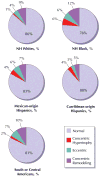Left ventricular mass and ventricular remodeling among Hispanic subgroups compared with non-Hispanic blacks and whites: MESA (Multi-ethnic Study of Atherosclerosis)
- PMID: 20117402
- PMCID: PMC2849669
- DOI: 10.1016/j.jacc.2009.08.046
Left ventricular mass and ventricular remodeling among Hispanic subgroups compared with non-Hispanic blacks and whites: MESA (Multi-ethnic Study of Atherosclerosis)
Abstract
Objectives: The purpose of this study was to examine the prevalence of left ventricular hypertrophy (LVH) and left ventricular (LV) remodeling patterns within Hispanic subgroups compared with non-Hispanic whites in the MESA (Multi-Ethnic Study of Atherosclerosis).
Background: Hispanics are the largest and fastest-growing ethnic minority in the U.S., but there are no data on LVH and LV geometry among Hispanic subgroups.
Methods: Cardiac magnetic resonance imaging was performed in 4,309 men and women age 45 to 84 years without clinical cardiovascular disease. Hispanics were categorized into subgroups based on self-reported ancestry. LVH was defined as the upper 95th percentile of indexed LV mass in a reference normotensive, nondiabetic, nonobese population, and LV remodeling according to the presence/absence of LVH and abnormal/normal LV mass to LV end-diastolic volume ratio.
Results: Among Hispanic participants, 574 were of Mexican origin, 329 were of Caribbean origin, and 161 were of Central/South American origin. On unadjusted analysis, only Caribbean-origin Hispanics (prevalence ratio = 1.2; 95% confidence interval [CI]: 1.03 to 1.4) had greater prevalence of hypertension than non-Hispanic whites. Hispanic subgroups were more likely to have LVH than non-Hispanic whites after adjustment for hypertension and other covariates (Caribbean-origin Hispanics = odds ratio [OR]: 1.8, 95% CI: 1.1 to 3.0; Mexican-origin Hispanics = OR: 2.2, 95% CI: 1.4 to 3.3; Central/South Americans = OR: 1.5, 95% CI: 0.7 to 3.1). All Hispanic subgroups also had a higher prevalence of concentric and eccentric hypertrophy compared with non-Hispanic whites (p < 0.001).
Conclusions: Caribbean-origin Hispanics had a higher prevalence of LVH and abnormal LV remodeling compared with non-Hispanic whites. A higher prevalence of LVH and abnormal LV remodeling was also observed among Mexican-origin Hispanics, despite a lower prevalence of hypertension. Differences among Hispanic subgroups regarding LVH and LV remodeling should be taken into account when evaluating cardiovascular risk in this population.
Copyright (c) 2010 American College of Cardiology Foundation. Published by Elsevier Inc. All rights reserved.
Figures




Similar articles
-
Left ventricular mass-geometry and silent cerebrovascular disease: The Cardiovascular Abnormalities and Brain Lesions (CABL) study.Am Heart J. 2017 Mar;185:85-92. doi: 10.1016/j.ahj.2016.11.010. Epub 2016 Dec 21. Am Heart J. 2017. PMID: 28267479 Free PMC article.
-
Left ventricular mass and geometry and the risk of ischemic stroke.Stroke. 2003 Oct;34(10):2380-4. doi: 10.1161/01.STR.0000089680.77236.60. Epub 2003 Sep 4. Stroke. 2003. PMID: 12958319 Free PMC article.
-
Racial/ethnic differences in the prognostic utility of left ventricular mass index for incident cardiovascular disease.Clin Cardiol. 2018 Apr;41(4):502-509. doi: 10.1002/clc.22914. Epub 2018 Apr 17. Clin Cardiol. 2018. PMID: 29663526 Free PMC article.
-
Asthma in Hispanics. An 8-year update.Am J Respir Crit Care Med. 2014 Jun 1;189(11):1316-27. doi: 10.1164/rccm.201401-0186PP. Am J Respir Crit Care Med. 2014. PMID: 24881937 Free PMC article. Review.
-
Peripheral artery disease and non-coronary atherosclerosis in Hispanics: another paradox?Prog Cardiovasc Dis. 2014 Nov-Dec;57(3):237-43. doi: 10.1016/j.pcad.2014.07.008. Epub 2014 Aug 2. Prog Cardiovasc Dis. 2014. PMID: 25443822 Free PMC article. Review.
Cited by
-
The Prevalence of Left Ventricular Hypertrophy in Obese Children Varies Depending on the Method Utilized to Determine Left Ventricular Mass.Pediatr Cardiol. 2016 Aug;37(6):993-1002. doi: 10.1007/s00246-016-1380-0. Epub 2016 Mar 31. Pediatr Cardiol. 2016. PMID: 27033247
-
Cardiovascular magnetic resonance in systemic hypertension.J Cardiovasc Magn Reson. 2012 Jun 11;14(1):28. doi: 10.1186/1532-429X-14-28. J Cardiovasc Magn Reson. 2012. PMID: 22559053 Free PMC article.
-
Left ventricular mass-geometry and silent cerebrovascular disease: The Cardiovascular Abnormalities and Brain Lesions (CABL) study.Am Heart J. 2017 Mar;185:85-92. doi: 10.1016/j.ahj.2016.11.010. Epub 2016 Dec 21. Am Heart J. 2017. PMID: 28267479 Free PMC article.
-
Racial and ethnic disparities in cardiometabolic disease and COVID-19 outcomes in White, Black/African American, and Latinx populations: Physiological underpinnings.Prog Cardiovasc Dis. 2022 Mar-Apr;71:11-19. doi: 10.1016/j.pcad.2022.04.005. Epub 2022 Apr 29. Prog Cardiovasc Dis. 2022. PMID: 35490869 Free PMC article. Review.
-
Population-based studies of myocardial hypertrophy: high resolution cardiovascular magnetic resonance atlases improve statistical power.J Cardiovasc Magn Reson. 2014 Feb 3;16(1):16. doi: 10.1186/1532-429X-16-16. J Cardiovasc Magn Reson. 2014. PMID: 24490638 Free PMC article.
References
-
- Health Disparities Experienced By Hispanics Reported by: Office of Minority Health, Office of the Director, CDC. Morb Mortal Wkly Rep. 2004;53:935–7. - PubMed
-
- Davidson JA, Kannel WB, Lopez-Candales A, et al. Avoiding the looming Latino/Hispanic cardiovascular health crisis: a call to action. Ethn Dis. 2007;17:568–73. - PubMed
-
- Ramirez RR, dela Cruz GP. Current Population Reports. U.S. Census Bureau; Washington, D.C: 2002. The Hispanic Population in the United States: March 2002; pp. 20–545.
-
- Hanis CL, Hewett-Emmett D, Bertin TK, Schull WJ. Origins of U.S. Hispanics. Implications for diabetes. Diabetes Care. 1991;14:618–27. - PubMed
-
- Racial/ethnic disparities in prevalence, treatment, and control of hypertension--United States, 1999–2002. MMWR Morb Mortal Wkly Rep. 2005;54:7–9. - PubMed
Publication types
MeSH terms
Grants and funding
LinkOut - more resources
Full Text Sources
Molecular Biology Databases

